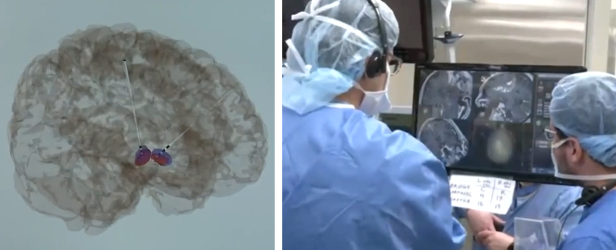Penn neurosurgeons are pioneers in the use of Deep Brain Stimulation (DBS) which has become the surgical standard of care for severe movement disorders, including Parkinson's disease, essential tremor, and generalized dystonia.
DBS is a minimally invasive brain surgery where two insulated wire electrodes are inserted deep into the brain to reach structures involved in these movement disorders. Then, in a separate surgery, a small battery — similar to a pacemaker — is implanted into the chest which will control the carefully titrated stimulation that will be delivered through the electrodes in the brain. The electrical impulse is intended to restore normal function to the targeted deep brain structures and better control movement and suppress tremor. When the patients are programmed, they will then also be given a controller to turn the device on and off as they please.
Recently, newer and more advanced technologies have come to market, allowing safer surgeries, more personalized dosing of stimulation using brain recordings and steering of current, and even more convenient, at-home device programming.
Dyskinesia
DBS is very successful and has also been used to treat dyskinesia caused by Parkinson's disease medications. Penn Medicine's Parkinson's Disease and Movement Disorders Center is one of the largest centers of its kind in the country with tremendous experience managing all aspects of Parkinson’s not limited to this transformative surgery.
Freezing of Gait
Freezing of gait (FoG) is one of the most disabling yet poorly understood symptoms of Parkinson's disease (PD). Additionally, gait freezing is poorly responsive to standard levodopa therapy or deep brain stimulation of standard brain targets such as the subthalamic nucleus or the globus pallidus interna. Dr. Iahn Cajigas, who most recently joined the Penn team is working to use DBS therapy in a novel brain target called the cuneiform nucleus for freezing of gait in patients with Parkinson’s disease as part of an ongoing clinical trial.
Chang, S. J., Cajigas, I., Guest, J. D., Noga, B. R., Widerström-Noga, E., Haq, I., Fisher, L., Luca, C. C., & Jagid, J. R. (2021). Deep brain stimulation of the Cuneiform nucleus for levodopa-resistant freezing of gait in Parkinson’s disease: study protocol for a prospective, pilot trial. Pilot and Feasibility Studies, 7(1), 117. https://doi.org/10.1186/s40814-021-00855-7
Treating Loss-of-Control Binge Eating

At least 3% of the population suffers from the common but underreported disorder of Binge Eating. For some, they've tried every medication available and undergone surgeries but the urge to eat is always there and the weight comes back. Dr. Halpern and his team of researchers discovered that a specific impaired brain circuit located within the nucleus accumbens, a key hub of the brain's reward center, may be the reason these impulses are being repeatedly triggered.
After doing a multitude of tests on mice, they learned that they could use Deep Brain Stimulation to calm the neurons from firing and could prevent the mice from binging on the food in front of them. This is when they realized it may be transferable to humans. Two women came forward who had tried to find multiple different solutions for their binge-eating but had no luck.
When the devices were implanted, Dr. Halpern didn't tell them when he would actually turn them on, but when he did, they have said they noticed immediately. Now the two of them are both experiencing weight loss and are eating differently without even thinking about it.
Now, Dr. Halpern and his team are actively seeking more applicants for this first of its kind procedure.
When published in Nature Medicine this pilot study was picked up by numerous outlets such as CBS Philly, Business Insider, WIRED, and the New York Times.